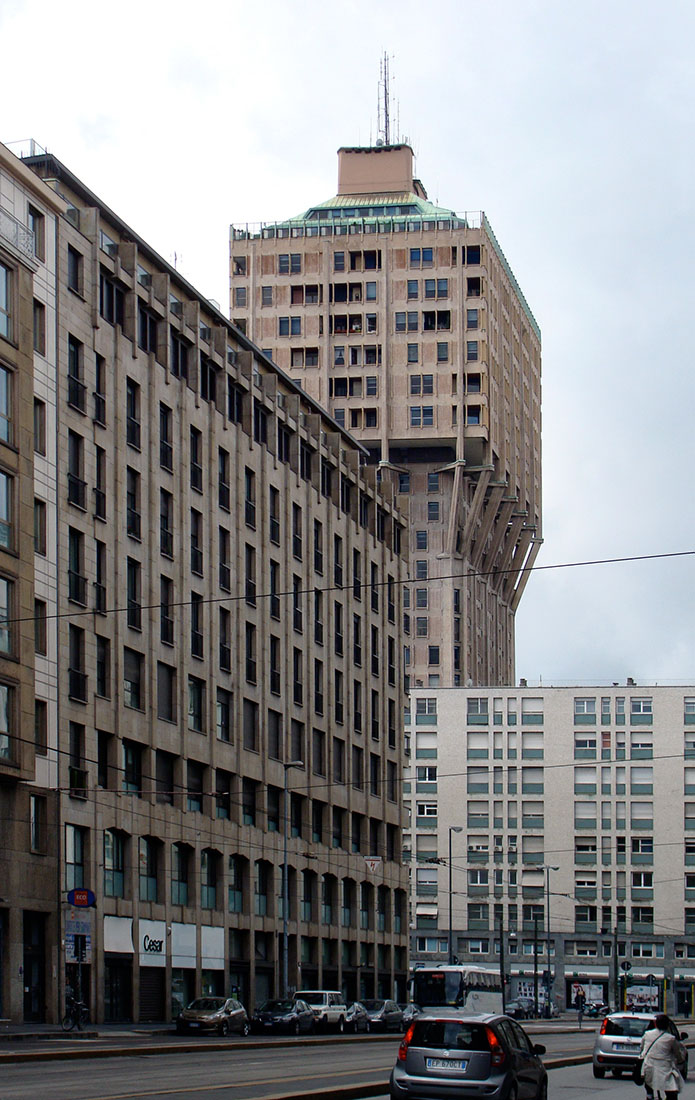 |
 |
 |
 |


Torre Velasca
Piazza Velasca 5, Milano
1950 - 1958
The
apartment and office high-rise building on Piazza Velasca 5, designed
by the architectural firm BBPR, is known as Torre Velasca.
As a consequence of its extraordinary nature, this construction is considered to be a symbol for the city of Milan. The uniqueness
of the Torre Velasca as an emblematic element identifies the building with the city of Milan. The building was realized in the late 1950s,
and contributes to the recognisability of the city, togehter with the Duomo, the Pirelli skyscraper and the Scala theater.
The building is named after Juan Fernández de Velasco, the three-time governor of the Duchy of Milan.
The Torre Velasca has been declared a national monument in 2011.
The design of the Torre Velasca marks a turning-point in the Italien post-war architectural panorama. It represents the disquieting break
with the modern movement and its uniform language of the International Style. The Torre Velasca was subject of harsh criticism and long debates
in Italy and elswhere. Even though, it is considered as an internationally renowned example of architecture. The striking appearance of the building
results from the overbearing dimensions, strongly characterised by a distinctive design. In an unusual design approach, the upper body of the building
projects over the lower body and towers over the surrounding urban texture. The lower 18 floors contain shops and offices while in the upper floors
of the widened section are located the apartments. Together with the Pirelli skyscraper, which dates from the same period,
the Torre Velasca is abruptly offset from the city skyline with its heigth of approximately 100 meters. Both buildings offer views into several directions,
which had before only been possible from the roof of the Duomo. The creation of office buildings often has the consequence, that residential structures
were pushed out of the centre. The combination of commercial and residential functions in the design of the Torre Velasca, however was considered as
prevention of the weakening of city centre.
The structure of the Torre Velasca recalls the Lombard tradition, made of medieval fortresses and towers, each having a massive profile.
In such fortresses, the lower parts were often narrower, while the higher parts became propped up, made of wooden boards or stone beams.
However, the projection responds to a particular requirement of use. This approach allowed that the apartments on top, which offer great views of the city,
gained space and appear to be more generous. Unlike most modern buildings, where windows, doors and materials are repeated over and over again, the Torre Velasca
shows numerous design patterns. They were created by using empty walls, open windows and reflective glass surfaces where windows would normally be expected.
This allows the building to satisfy the different needs of the many people using it, and at the same time enlivens the elevations.
As a consequence of its extraordinary nature, this construction is considered to be a symbol for the city of Milan. The uniqueness
of the Torre Velasca as an emblematic element identifies the building with the city of Milan. The building was realized in the late 1950s,
and contributes to the recognisability of the city, togehter with the Duomo, the Pirelli skyscraper and the Scala theater.
The building is named after Juan Fernández de Velasco, the three-time governor of the Duchy of Milan.
The Torre Velasca has been declared a national monument in 2011.
The design of the Torre Velasca marks a turning-point in the Italien post-war architectural panorama. It represents the disquieting break
with the modern movement and its uniform language of the International Style. The Torre Velasca was subject of harsh criticism and long debates
in Italy and elswhere. Even though, it is considered as an internationally renowned example of architecture. The striking appearance of the building
results from the overbearing dimensions, strongly characterised by a distinctive design. In an unusual design approach, the upper body of the building
projects over the lower body and towers over the surrounding urban texture. The lower 18 floors contain shops and offices while in the upper floors
of the widened section are located the apartments. Together with the Pirelli skyscraper, which dates from the same period,
the Torre Velasca is abruptly offset from the city skyline with its heigth of approximately 100 meters. Both buildings offer views into several directions,
which had before only been possible from the roof of the Duomo. The creation of office buildings often has the consequence, that residential structures
were pushed out of the centre. The combination of commercial and residential functions in the design of the Torre Velasca, however was considered as
prevention of the weakening of city centre.
The structure of the Torre Velasca recalls the Lombard tradition, made of medieval fortresses and towers, each having a massive profile.
In such fortresses, the lower parts were often narrower, while the higher parts became propped up, made of wooden boards or stone beams.
However, the projection responds to a particular requirement of use. This approach allowed that the apartments on top, which offer great views of the city,
gained space and appear to be more generous. Unlike most modern buildings, where windows, doors and materials are repeated over and over again, the Torre Velasca
shows numerous design patterns. They were created by using empty walls, open windows and reflective glass surfaces where windows would normally be expected.
This allows the building to satisfy the different needs of the many people using it, and at the same time enlivens the elevations.